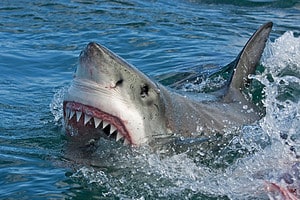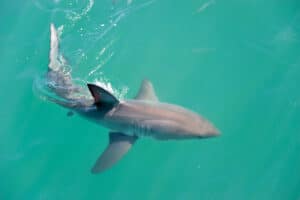The three fastest fish on the planet are the sailfish, black marlin, and swordfish. These fish can reach speeds between 60-70mph! They have an aerodynamic shape and large dorsal fin that expands like a sailboat creating optimal conditions for speed. As young they have scales, but adult swordfish do not have scales. Next fastest are the wahoo, tuna and bonito. Wahoos have tiny scales, tunas have larger scales around their shoulder area and smaller scales as well and the bonito, a smaller fish compared to the Billfish, growing to be about 30 inches, is covered in scales.
So, what about sharks? The next fastest fish are the mako shark and blue shark, clocking speeds of 40mph. Sharks do have scales, they have one of four kinds of scales called placoid scales, also called dermal denticles. Do these scales make them one of the top ten fastest fish? Let’s find out more about scales and especially the shark scales.
What types of scales do sharks have?
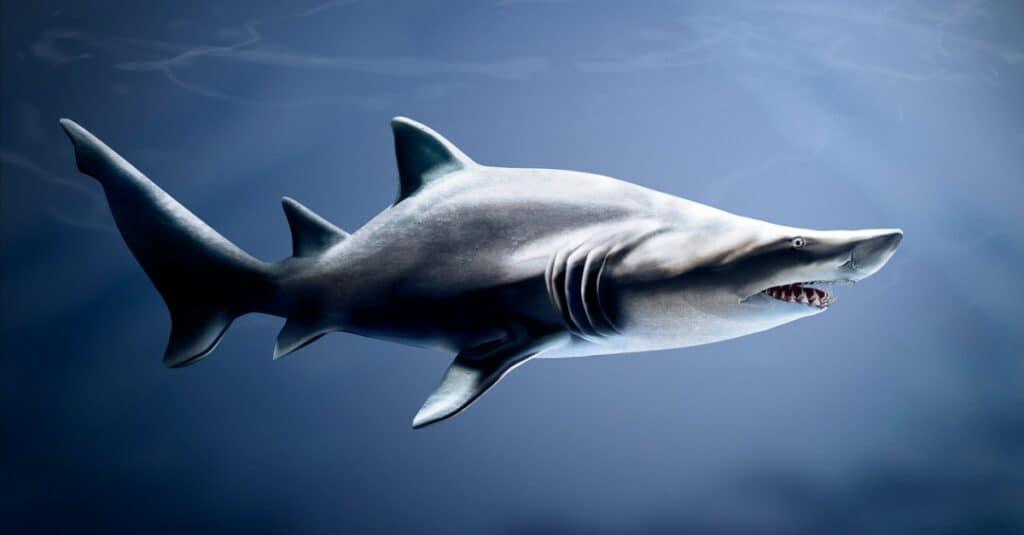
Sharks have placoid scales that are leaf-shaped.
©iStock.com/mirror-images
You might think that most fish have similar scales, but the truth is there are four major types of scales found in fish. Sharks have placoid scale that are small and leaf-shaped. Other related fish (cartilaginous fish) like rays and skates also have placoid scales. Let’s dive into the different types of scales.
Ctenoid scales: spiney or comb-like ends, found on boney fish.
- Perches
- Sunfish
- Bass
Cycloid scales: smooth rounded edge, also found on boney fish.
- Trout
- Herring
- Carp
- Salmon
Ganoid scales: rhomboid in shape and have peg and socket joints between them.
- Gars
- Bowfin
- Paddlefish
- Sturgeons
Placoid scales: small leaf-shaped scales also known as dermal denticles because they grow out of the dermis layer, found on cartilage fish like sharks and rays.
- Sharks
- Rays
- Skates
In addition, some species of fish have more than one kind of scales:
- Flounder: one side is ctenoid (the side with their eyes) and one side is cycloid (backside)
- Soles: one side is ctenoid (the side with their eyes) and one side is cycloid (backside)
Fish with no scales include:
- Eels
- Anglerfish
- Catfish
- Clingfish
What are shark scales made of?
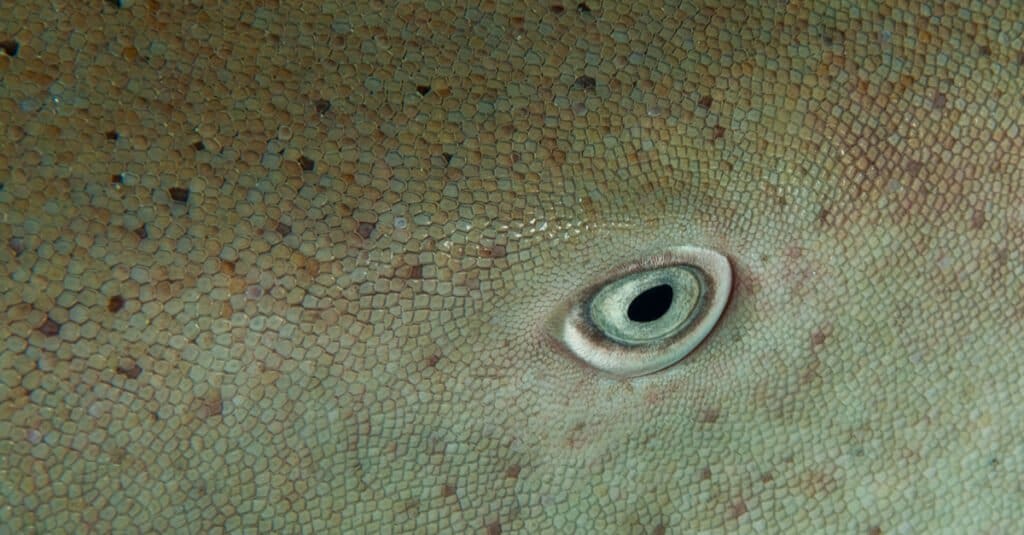
Shark scales are more like teeth than fish scales.
©aspas/Shutterstock.com
The placoid scales on sharks are more like teeth than fish scales. They have an inner cavity of pulp similar to human teeth and it is covered with a protective enamel made from dentine. The scales overlap each other and are called dermal denticles because they grow out from the dermis. Scales on sharks stop growing, unlike scales of bony fish that continue to grow as the fish grows. Instead, new scales fill in on sharks to create a streamlined surface. If you were to pet a shark from head to tail it would feel slick and smooth, however if you accidently rubbed up against a shark from tail to head it would be abrasive and may even cause a laceration.
Why do sharks have scales?
Sharks have scales for three reasons. First they are a form of protection. They actually have two sizes of scales on their bodies with smaller, thinner scales near their gills and on their fins and bigger, thicker scales on the rest of their bodies. The larger scales serve as an armor to protect them from other sharks and killer whales as well as ectoparasites. Researchers found that the small-spotted catfish will curl-up like a donut when threatened and its scales provide a protective shell.
Secondly, shark scales reduce the friction with the water and provide sharks the ability to swim fast. Researchers studying the sailfish and swordfish compared their scales and skin and found that “the ribbed structure found in the shark skin which reduces [the] skin friction by maximum 8%”. The design of shark scales has been used to make swimsuits for Olympic Swimmers in hope of cutting down swim times, and it has worked! The unique pattern and size of the scales has been replicated and it has made swimmers swim faster. Engineers are trying new ways to replicate the scale patterns to use on boats and aircraft with the goal of being able to be more fuel efficient.
Thirdly, the unique scale design of placoid scales helps sharks swim quieter, sometimes undetected. One research study wanted to see if sharks could tell if they were approaching a human in front of them or if they were able to identify their body orientation and purposefully sneak up on them from behind. They had divers kneel at the bottom of the ocean and the researches watched how the sharks approached them. The first part of the study had one diver kneeling, the second part of the study had two divers kneeling back-to-back. For the single diver the sharks repeatedly tried to stay out of the line of vision of the diver! Having scales that help you remain quiet add to the stealth character of these sharks.
What other animals have scales?
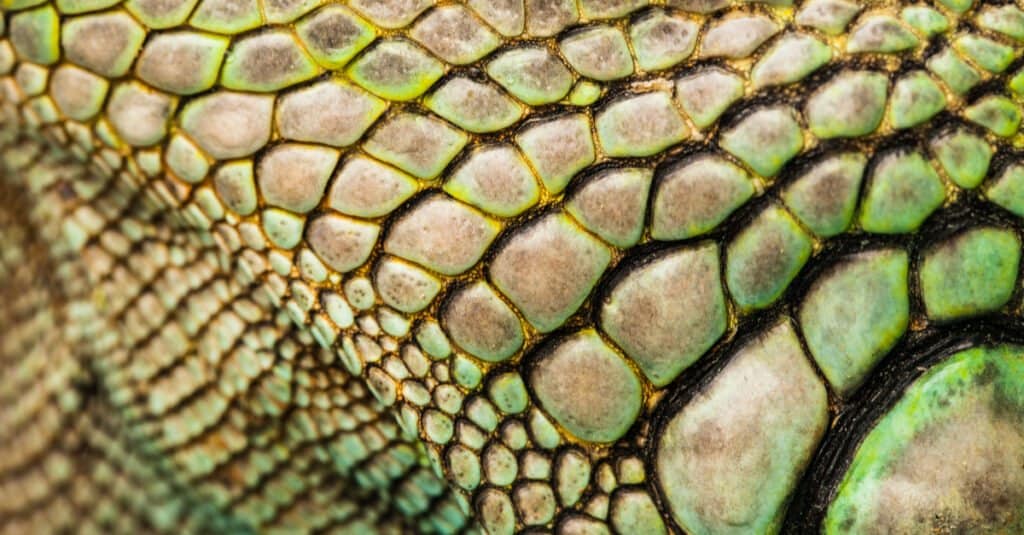
Reptiles also have scales that cover their entire body
©Chaikom/Shutterstock.com
Beyond sharks, other animals have scales. Let’s look in at some other major types of animals and whether or not they have scales.
Reptiles with scales: epidermal scales that cover their whole body.
- Snakes
- Lizards
- Turtles and crocodiles have dermal scutes (bony plates that are waterproof)
Mammals with scales: terrestrial scales, very few mammals have scales.
- Pangolins
- Armadillos
- Musky rat-kangaroos
- Scaley-tailed squirrels (scales just on their tails)
Arthropods with scales: wings are covered in tiny scales that give the wings their color and help with temperature regulation.
- Butterflies
- Moths
Birds with scales: birds have scales on their legs, sometimes just on their tarsals but sometimes their whole leg.
- Eagles: the thick scales on their talons protect their feet when they capture fish and other prey
- Hawks
- Owls
Do amphibians have scales?
Amphibians are animals that are vertebrates, having a backbone, and can breathe through their skin. There are even some salamanders that do not have lungs or gills and get all of their oxygen through their skin. Common amphibians are frogs, salamanders, and newts. So, do they have scales? No! They are covered in a protective mucus that protects them from toxins and from drying up. Most have smooth skin, but some toads have bumpy skin with glands that produce a toxic secretion of their own. Remember how frogs often start out as tadpoles that are completely aquatic and then morph into adults? Neither tadpoles nor adult frogs have scales.
Do the shark scale-like swimsuits of Olympic swimmers make them as fast as sharks?
The two fastest sharks, the mako shark and the blue shark have been recorded going 40mph. Try putting your head out the window of your car going 40! One of the fastest Olympic swimmers, Michael Phelps swam the 200-meter freestyle in 1.42 minutes which is 4.7mph. Until we grow fins and tails I believe that sharks will always outswim humans no matter how fancy our swimsuits are.
The photo featured at the top of this post is © Fiona Ayerst/Shutterstock.com
Thank you for reading! Have some feedback for us? Contact the AZ Animals editorial team.



